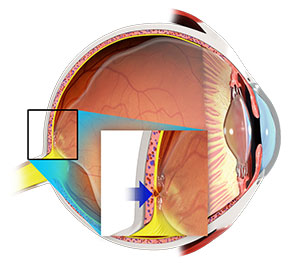
What is Vitreomacular Traction Syndrome?
Vitreomacular traction syndrome is an eye disorder that leads to vision problems. It occurs when the vitreous gel does not completely detach from the retina and remains partially attached to the macula - the central part of the retina responsible for clear and detailed vision. This tends to displace or pull the macula outwards and distorts the normal vision.
The vitreous gel is a clear fluid present in your eye while the retina is the light-sensitive nerve layer present at the back of your eye.
What are the Causes of Vitreomacular Traction Syndrome?
Vitreomacular traction syndrome may be caused due to:
- Age-related macular degeneration
- Diabetes induced retinopathy
- Chronic eye disorders
- Extreme near-sightedness
Vitreomacular traction syndrome is more common in women.
What are the Symptoms of Vitreomacular Traction Syndrome?
The common symptoms of vitreomacular traction syndrome may include:
- Blurred vision
- A hole in the macula
- Distorted vision
- Blind spots may develop in the center of your vision
How is Vitreomacular Traction Syndrome Diagnosed?
Your eye specialist/ophthalmologist will perform a dilated eye exam using special eye drops that are used to dilate your eye and view the retina. This helps assess the complete health of your eye.
Other diagnostic tests may include:
Optical coherence tomography (OCT) scan: In this test, light waves are used to obtain detailed images of the retina, to determine the extent of vitreomacular traction.
Ocular ultrasound: In this test, high-frequency sound waves are used to obtain the images of the retina.
Fluorescein angiogram: In this test, a dye called fluorescein is injected into a vein, usually in your arm. The dye travels through the bloodstream and reaches your eye and makes it appear brighter. At this stage, the images of the retina are taken using a special camera.
This test is performed if there is damage to the surrounding blood vessels.
What are the Treatments Available for Vitreomacular Traction Syndrome?
Vitreomacular traction syndrome may not require treatment if the symptoms are mild. However, if you experience severe symptoms that hinder your day to day activities and you experience loss of vision, then your doctor will recommend surgery.
Injections: In a small number of people with vitreomacular traction syndrome, their doctor might inject traction-reducing medication in the eye to restore the macula without the need for surgery.
Surgery: In case of surgery, the vitreous fluid is removed from the eye and the remaining part sticking to the macula is also removed. Any scar tissue that may be growing over the macula, can be gently removed using micro-forceps.
Related Topics
- Retinal Detachment
- Retinal Tear
- Diabetic Retinopathy
- Age-Related Macular Degeneration
- Retinal Vascular Diseases
- Retinal Artery Occlusion
- Retinal Vein Occlusion
- Retinal Hemorrhage
- Vitreous Hemorrhage of any Etiology
- Central Serous Retinopathy
- Posterior Vitreous Detachment
- Vitreomacular Traction Syndrome
- Epiretinal Membrane
- Macular Edema
- Macular Hole
- Retinoschisis
- Ocular Ischemic Syndrome
- Cystoid Macular edema
- Color Blindness
- Nyctalopia/Night Blindness
- Cone Dystrophy
- Choroideremia
- Retinopathy of Prematurity
- Uveitis & Ocular Inflammation
- Retinoblastoma

